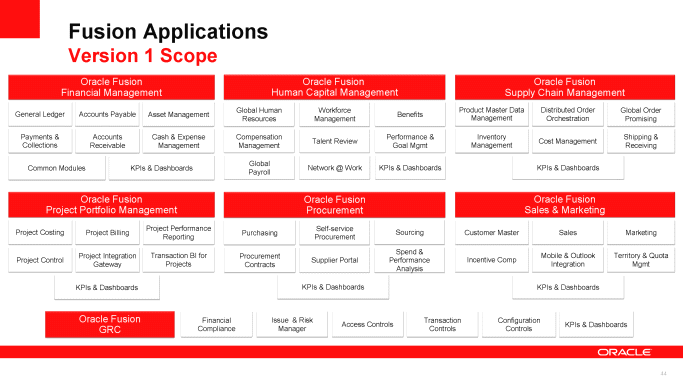One Code To Rule Them All: Reflections On Oracle Fusion Applications From Oracle OpenWorld 2010
With about 41,000 attendees, 1,800 sessions, and a whooping 63,000-plus slides, Oracle OpenWorld 2010 (September 19-23) in San Francisco was certainly a mega event with more information than one could possibly digest or even collect in a week. While the main takeaway for every attendee depends, of course, on the individual’s area of interest, there was a strong focus this year on hardware due to the Sun Microsystems acquisition. I’m a strong believer in the integration story of “Hardware and Software. Engineered to Work Together.” and really liked the Iron Man 2 show-off all around the event; but, because I’m an application guy, the biggest part of the story, including the launch of Oracle Exalogic Elastic Cloud, was a bit lost on me. And the fact that Larry Ellison basically repeated the same story in his two keynotes didn’t really resonate with me — until he came to what I was most interested in: Oracle Fusion Applications!
 Oracle Fusion Applications is the result of five years of development, the biggest R&D investment Oracle has ever made. The launch is finally planned for Q1 2011 (let’s keep our fingers crossed) with 101 modules and seven product families that will be generally available at the same time. After Oracle Fusion Middleware for its whole platform portfolio, the company finally delivers with Oracle Fusion Applications on its vision of a common code platform for all its applications. All applications? Well, Oracle Fusion Applications won’t cover the entire spectrum of its business Application offerings but a comprehensive part and expand its scope over time (see Figure 1). It is rather meant to complement existing application investments and to grow its presence relatively slowly in the market. Larry Ellison expects 50 to 100 Oracle Fusion Application customers over the first half of 2011 to start. A detailed analysis of possible market scenarios was published in the blog of my colleague Andy Bartels.
Oracle Fusion Applications is the result of five years of development, the biggest R&D investment Oracle has ever made. The launch is finally planned for Q1 2011 (let’s keep our fingers crossed) with 101 modules and seven product families that will be generally available at the same time. After Oracle Fusion Middleware for its whole platform portfolio, the company finally delivers with Oracle Fusion Applications on its vision of a common code platform for all its applications. All applications? Well, Oracle Fusion Applications won’t cover the entire spectrum of its business Application offerings but a comprehensive part and expand its scope over time (see Figure 1). It is rather meant to complement existing application investments and to grow its presence relatively slowly in the market. Larry Ellison expects 50 to 100 Oracle Fusion Application customers over the first half of 2011 to start. A detailed analysis of possible market scenarios was published in the blog of my colleague Andy Bartels.
So why am I excited about Oracle Fusion Applications? It’s the concept of a single code that supports more or less all of the key trends we currently see in the market that are reshaping the software industry. The four pillars that Oracle’s Fusion Applications are built on are:
- 100% open standards.Well, this may not be groundbreaking or new, but it’s an essential requirement that far too often is still not met by standard software application vendors.
- Embedded business intelligence.Woot, I really love this one. With business intelligence (BI) as one of my key coverage areas, I see tremendous opportunity for this new feature to make BI more pervasive and to provide intelligence directly to the workspace where business decision are made through Oracle Business Intelligence 11g.
- Embedded Web 2.0 collaboration.This is a nice one too! Instead of standalone collaboration tools, why not integrate them right away into the process applications? Now combine this with business insights and analytics, shared in collaborative decision processes, and you’ll see the opportunity for how such a combination will improve and accelerate business performance.
- On-premise and on-demand.This is the highlight for me as a cloud geek! No question, cloud computing is on the march, and software-as-a-service (SaaS) is the biggest and fastest growing cloud market today. Several vendors have started to complement their traditional on-premise offerings with SaaS applications, but most are actually using different solutions on different code platforms for both offerings. However, while there is still a lot of cloud confusion in the market, what customers need most is confidence in the right strategy and the flexibility to move between different deployment options. Only a common platform will allow smooth transition between cloud and on-premise deployments to adjust the strategy to changing needs, combined with the protection of existing investments.
Taking the above value points into consideration, Oracle’s competitors, namely SAP, will face stiff competition when Oracle Fusion Applications hits the road. The years of missing innovation at SAP will give Oracle a clear advantage over SAP’s comparable solution portfolio. SAP has just started to launch some initial applications with integrated business intelligence (e.g., SAP BusinessObjects analytic applications for industries), but it hasn’t articulated a general strategy in this direction. Also, the company is still playing with new standalone collaboration tools (e.g., SAP StreamWork), which are not even fully integrated with the SAP Business Suite. Last, but not least, SAP’s current OnDemand and on-premise solutions are built on totally different technologies. Its OnDemand portfolio alone uses five different platforms (ByDesign, Frictionless, NetWeaver, Clear Standards, and BusinessObjects); and, while consolidation does appear to be happening, slowly, it has not been established as a strategic direction either. SAP’s latest pet of in-memory technology is a nice, innovative feature, but it won’t address the most pressing market needs — there will be a long way to go until it will catch up with Oracle Fusion Applications.
Please leave a comment or contact me directly.
Kind regards,
Holger Kisker